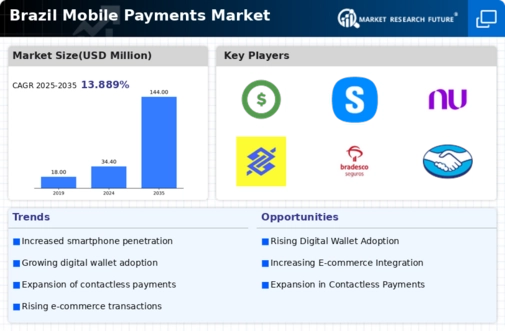E-commerce Growth
The rapid expansion of e-commerce in Brazil serves as a significant catalyst for the mobile payments market. In 2025, e-commerce sales are projected to reach approximately $30 billion, with a substantial portion of these transactions being conducted via mobile devices. This shift towards online shopping has prompted consumers to seek convenient payment methods, thereby increasing the demand for mobile payment solutions. Retailers are responding by integrating mobile payment options into their platforms, enhancing the overall shopping experience. Furthermore, the rise of social commerce, where transactions occur through social media platforms, further propels the mobile payments market, as consumers prefer seamless payment experiences while engaging with brands online.
Rise of Fintech Innovations
The emergence of fintech companies in Brazil is reshaping the landscape of the mobile payments market. These innovative firms are introducing a variety of solutions that cater to the diverse needs of consumers and businesses alike. By leveraging technology, fintechs are providing faster, more secure, and user-friendly payment options. As of 2025, the number of fintech startups in Brazil has surged, with many focusing on mobile payment solutions. This influx of competition is driving down costs and enhancing service quality, which is likely to attract more users to mobile payment platforms. The dynamic nature of the fintech sector appears to be a key driver in the ongoing evolution of the mobile payments market.
Increasing Smartphone Penetration
The proliferation of smartphones in Brazil is a pivotal driver for the mobile payments market. As of 2025, approximately 80% of the Brazilian population owns a smartphone, facilitating access to mobile payment applications. This trend indicates a growing consumer base that is increasingly comfortable with digital transactions. Mobile payments offer convenience that aligns with the fast-paced lifestyle of urban Brazilians. They seek efficient payment solutions. Moreover, the rise in smartphone usage is complemented by improved internet connectivity, with over 70% of the population having access to 4G or higher networks. This technological advancement not only enhances user experience but also encourages merchants to adopt mobile payment systems, thereby expanding the mobile payments market in Brazil.
Consumer Preference for Convenience
The growing consumer preference for convenience is a notable driver of the mobile payments market in Brazil. As lifestyles become increasingly hectic, Brazilians are gravitating towards payment methods that save time and effort. Mobile payments offer a streamlined alternative to traditional cash or card transactions, allowing users to complete purchases quickly and efficiently. Surveys indicate that over 60% of consumers in Brazil prefer mobile payments for their ease of use and speed. This shift in consumer behavior is prompting businesses to adopt mobile payment solutions to meet customer expectations. Consequently, the mobile payments market is likely to experience sustained growth as more consumers prioritize convenience in their purchasing decisions.
Government Initiatives and Regulations
Brazilian government initiatives aimed at promoting digital financial inclusion significantly impact the mobile payments market. The Central Bank of Brazil has implemented regulations that encourage the use of mobile payment systems, such as the Instant Payment System (PIX), which has gained traction since its launch. As of late 2025, PIX accounts for over 30% of all transactions in the country, showcasing the effectiveness of government policies in driving adoption. These initiatives not only enhance consumer trust in mobile payments but also foster competition among service providers, leading to innovative solutions and lower transaction costs. Consequently, the regulatory environment appears to be a crucial factor in shaping the mobile payments market in Brazil.



















Leave a Comment